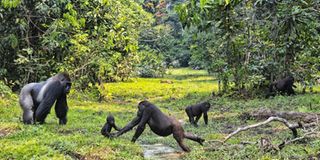Prime
Mt Elgon designation provides timely tonic

What you need to know:
These targets include designating 30 percent of the earth’s land surface as protected areas and restoring 30 percent of the planet’s degraded ecosystems by 2030
United Nations Educational, Scientific and Cultural Organisation (Unesco) last month designated the Mount Elgon Transboundary Biosphere Reserve shared by Uganda and Kenya, and the Rufiji-Mafia-Kibiti-Kilwa Biosphere Reserve (RUMAKI) in Tanzania, among the 11 new biosphere reserves around the world.
Biosphere reserves are a pillar of Unesco’s mandate as the United Nations sciences agency. Each biosphere reserve promotes innovative local solutions. They contribute to countries achieving the targets adopted last December within the framework of the Convention on Biological Diversity’s Kunming–Montreal Global Biodiversity Framework.
These targets include designating 30 percent of the earth’s land surface as protected areas and restoring 30 percent of the planet’s degraded ecosystems by 2030.
“Unesco’s biosphere reserves are tangible proof that humanity can live in balance with nature. Since 1971, this community-led programme has successfully found a model for development where people live well and biodiversity is respected,” said Audrey Azoulay, the Unesco director general.
The designation of the Mount Elgon Transboundary Biosphere Reserve consolidates the water tower functions of the Mount Elgon Biosphere Reserve in Kenya (2003) and the Mount Elgon Biosphere Reserve in Uganda (2005). This provides a range of ecosystem functions and supports forests, wildlife and livelihoods in the area.
Bird sanctuary
Home to more than 300 bird species, the site has an exceptional diversity of ecosystems as well as plant and animal species. These are distributed across four distinct ecological zones characterised by different vegetation types.
The transboundary biosphere reserve has a population of nearly 1,150,000 that is evenly split between Kenya and Uganda.
The area is inhabited by a diverse population of Sabaot, Luhya, Teso, Bagisu as well as other indigenous people and local communities.
The inhabitants rely on gathering forest products such as firewood, fodder, medicinal plants, vegetables, bamboo shoots, stakes, mushrooms, thatching grass and salt for their cattle. Several community conservation initiatives and programmes have been implemented as a way of securing community support for conserving the ecosystem.
“The declaration of Mt Elgon as a Transboundary Man and Biosphere Reserve implies the international community recognises the role Mt Elgon plays in linking the community livelihoods and conservation of the ecosystem of Uganda and Kenya,” Mr Sam Mwandha, the executive director of Uganda Wildlife Authority (UWA), told Saturday Monitor.
UWA, which is responsible for the management and protection of wildlife in and outside protected areas, has promised to work with players in Kenya to, Mr Mwandha said, prop programmes that “enhance ecosystem health as well as improve community livelihoods.”
He added: “We will continue to enhance our community awareness programmes through village meetings, school visits and training in improved agriculture systems that lead to better productivity and less conflict.”
The tourism activities in Mount Elgon National Park include bird watching, summit hikes, nature walks, and cave visits.
“Mt Elgon is still relatively unknown to many a visitor. We, however, are working to provide more information to potential tourists. Ugandans and other tourists continue to visit Mt Elgon in increasing numbers and we hope we can have this continue,” Mr Mwandha said, adding: “We will also engage our colleagues in Kenya to strengthen transboundary tourism on Mt Elgon, which started almost two decades ago but has waned over time.”
Unplugging Africa’s biosphere reserves
Tanzania: Rufiji-Mafia-Kibiti-Kilwa Biosphere Reserve (RUMAKI)
The RUMAKI Biosphere Reserve is administratively located in the regions of Lindi (Kwila District) and Pwani (Rufiji, Mafia and Kibiti districts) of Tanzania. The area is predominately a complex coastal–marine ecosystem that includes the first marine protected area in Tanzania, Mafia Island Marine Park (1994).
It comprises an outstanding mosaic of tropical marine habitats, including coral reefs, seagrass beds, mangroves and intertidal areas that support populations of turtles, migrating birds, dolphins and whale sharks. The RUMAKI seascape is recognised as being the most biologically productive and diverse marine area in East Africa.
Central African Republic: Protected Area Complex of Northeast Central African Republic Biosphere Reserve
This biosphere reserve is located in the north-east of the country, in the transition zone between the Sahelian area to the north and the humid Equatorial area to the south. The site plays an important ecological role by connecting protected areas at the national and regional levels.
Situated at the convergence of the Congo, Lake Chad and Nile Basins, the biosphere reserve possesses highly diverse groups of plant and animal species, as well as ecosystems and landscapes characterised by forest areas along rivers flanked by floodplains. One of its core areas, Manovo-Gounda St Floris National Park, is already inscribed on the World Heritage list.
Cameroon: Korup Rainforest Biosphere Reserve
At over 60 million years old, Korup Rainforest is one of Africa’s oldest rainforests. Located in the Guineo-Congolian biogeographical region in southwest Cameroon, contiguous with the Oban Biosphere Reserve in Nigeria, the Korup Rainforest Biosphere Reserve has a wide landscape that ranges from lowland forest to subtropical montane rainforest.
It has been designated as one of Africa’s two Pleistocene Refugia for its rich biodiversity and endemic fauna and flora. The biosphere reserve harbours a significant population of African primates, including the critically endangered Cross River Gorilla.




